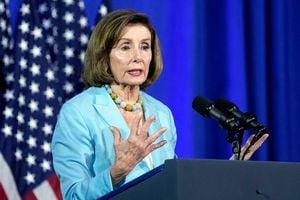Hog markets across the United States entered the weekend of September 12, 2025, with a noticeable downward trend, as lean hog futures and cash prices both eased after what had been a stronger week of trading. According to Barchart.com, prices for hogs were softening as the weekend approached, reflecting a broader sense of volatility that has characterized livestock markets in recent months.
On Friday, September 12, lean hog futures declined by 12 to $1.07, capping off a week that had seen some optimism earlier on. The U.S. Department of Agriculture’s (USDA) national base hog report, released that morning, indicated an average trade price of $103.96. This figure marked a drop of $3.68 from the previous day, signaling a notable adjustment in the cash market. The CME Lean Hog Index, which tracks the average price paid for hogs, had ticked up by 11 cents just two days earlier, reaching $106.04 on September 10. This brief uptick, however, was not enough to stave off the broader downward movement by week’s end.
Despite the softening futures and cash prices, the pork cutout market showed a different story. The USDA’s FOB plant pork cutout report from Friday morning revealed that prices had rebounded by $1.68, reaching $114.85 per hundredweight (cwt). This rise was driven by gains across most primal cuts, with the notable exception of the picnic primal, which was the only category to register a decline. The pork cutout value is a composite of prices paid for various pork cuts, and its increase suggests that demand for certain products remains robust even as live hog prices waver.
Slaughter numbers, a key indicator of both supply and demand, also painted an interesting picture. The USDA estimated that 487,000 head of hogs were federally inspected for slaughter on Thursday, September 11. That brought the week’s total to 1.947 million head—an increase of 8,342 compared to the same week last year. The uptick in slaughter volume suggests that processors are keeping a strong pace, perhaps in anticipation of continued demand for pork products as the fall season approaches.
Looking at futures contracts, the decline was evident across the board. October 2025 hog futures closed at $97.100, down $1.075. December 2025 contracts settled at $88.825, a decrease of $0.425, while February 2026 futures were at $90.450, down $0.125. These figures, reported by Barchart.com, reflect a market that is recalibrating after recent gains, with traders apparently cautious about the outlook for the remainder of the year and into early 2026.
Market participants have been closely watching a range of factors that could influence prices moving forward. Feed costs, export demand, and domestic consumption trends all play a role in determining the direction of the hog market. While the recent drop in futures prices may give some producers pause, the increase in pork cutout values offers a glimmer of hope that consumer demand for pork remains healthy.
According to Barchart.com, the volatility seen in the market this week is not unusual. Livestock markets often experience sharp swings in response to supply chain disruptions, changing weather patterns, and shifts in consumer behavior. This week’s price action may have been influenced by a combination of these factors, as well as broader economic uncertainties that continue to ripple through the agricultural sector.
Some analysts point to the increase in slaughter numbers as a sign that producers are moving hogs to market more quickly, possibly out of concern that prices could drift lower in the coming weeks. Others suggest that the strong pork cutout values indicate that retailers and foodservice operators are still willing to pay up for high-quality product, which could help support prices if supply tightens later in the year.
It’s also worth noting that the difference between the cash market and the futures market has widened in recent days. The national base hog price, as reported by the USDA, was $103.96 on Friday, while October futures were trading at $97.100. This gap, sometimes referred to as the basis, can be a signal of market expectations about future supply and demand conditions. A wide basis may prompt producers and packers to adjust their marketing strategies, potentially accelerating sales or holding back inventory in anticipation of more favorable prices.
For producers, the current environment presents both challenges and opportunities. The softening of futures prices may squeeze margins for those who have not locked in higher prices through forward contracts. At the same time, the rebound in pork cutout values could offer some relief, particularly for integrated operations that are able to capture value across the supply chain.
Investors and traders remain cautious, as reflected in the modest declines across the futures curve. The views expressed by Austin Schroeder, as noted in Barchart.com’s reporting, underscore the importance of careful risk management in such a volatile environment. Schroeder disclosed that he did not have direct or indirect positions in any of the securities mentioned, a reminder of the need for transparency in financial reporting.
As always, the outlook for the hog market will depend on a complex interplay of factors. Export demand, particularly from key markets like China and Mexico, remains a wild card. Any disruption to trade flows could quickly alter the supply-demand balance. At the same time, domestic consumption patterns—shaped by everything from grilling season to back-to-school routines—will continue to influence prices in the months ahead.
Looking ahead, market watchers will be paying close attention to upcoming USDA reports, weather forecasts, and economic indicators that could affect both the supply of hogs and the demand for pork products. In a market where fortunes can shift quickly, adaptability and vigilance are key.
This week’s developments serve as a vivid reminder that the hog market is anything but predictable. With prices easing into the weekend and futures signaling caution, producers, processors, and traders alike will be watching for the next signal that could tip the balance one way or the other.
For now, the story of September 2025 is one of adjustment—a market recalibrating after recent gains, with all eyes on the factors that will shape the road ahead.



